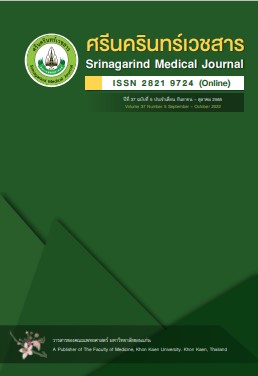ประสิทธิผลของการใช้ท่อพลิกคว่ำ-หงายมือในผู้ป่วยโรคหลอดเลือดสมองระยะฟื้นฟู: การศึกษาแบบสุ่มและมีกลุ่มควบคุม
Effectiveness of Pronate-Supinate Pipe in Sub-Acute Stroke Patients: A Randomized Controlled Trial
Abstract
รยางค์บนหลังการเกิดโรคหลอดเลือดสมอง การศึกษาครั้งนี้มีวัตถุประสงค์เพื่อพัฒนาอุปกรณ์ท่อฝึกพลิกคว่ำ-หงายมือ ซึ่งเป็นนวัตกรรมใหม่ในการเพิ่มความแข็งแรงของกล้ามเนื้อ และเพื่อทดสอบประสิทธิภาพของท่อฝึกพลิกคว่ำ-หงายมือ
วิธีการศึกษา: การศึกษานี้เป็นการทดลองแบบสุ่มและมีกลุ่มควบคุมในอาสาสมัครโรคหลอดเลือดสมองระยะกึ่งเฉียบพลันจำนวน 16 ราย โดยใช้วิธีการสุ่มเข้ากลุ่มทดลองและกลุ่มควบคุมจำนวนกลุ่มละ 8 ราย
ทั้ง 2 กลุ่มได้รับการฟื้นฟูทางกายภาพบำบัดแบบดั้งเดิม ครั้งละ 45 นาที จำนวน 3 ครั้งต่อสัปดาห์ เป็นเวลา 4 สัปดาห์ กลุ่มทดลองได้รับการฝึกความแข็งแรงของกล้ามเนื้อกำมือโดยใช้ท่อ จำนวน 15 ครั้ง ต่อเซตจำนวน 3 เซต แล้วพัก 2 นาที จนกว่าจะครบ 30 นาที แล้วตามด้วยการฝึกกายภาพบำบัดแบบดั้งเดิม ตัวแปรหลักในการศึกษาครั้งนี้ได้แก่ การทำงานของรยางค์บนข้างอัมพาต ประเมินโดย Streamlined Wolf Motor Function Test ฉบับสำหรับผู้ป่วย sub-acute stroke (SWMFT-sub-acute) ตัวแปรรองได้แก่ องศาการเคลื่อนไหวด้วยตนเองเองในท่าพลิกคว่ำ-หงายมือ แรงบีบมือ และการฟื้นตัวของระบบประสาทสั่งการรยางค์บน ประเมินโดย goniometer, hand grip dynamometer และ Fugl-Meyer assessment for upper extremity (FMA-UE) ตามลำดับ โดยประเมินก่อนและหลังได้รับโปรแกรมการรักษา
ผลการศึกษา: พบว่า การทำงานของรยางค์บนข้างอัมพาต องศาการเคลื่อนไหวด้วยตนเองในท่าคว่ำ-หงายมือ แรงบีบมือ และการฟื้นตัวของระบบประสาทสั่งการรยางค์บน ของอาสาสมัครกลุ่มทดลอง เพิ่มขึ้นอย่างมีนัยสำคัญทางสถิติ (p < 0.05) อย่างไรก็ตาม ไม่พบความแตกต่างกับกลุ่มควบคุม
สรุป: ท่อพลิกคว่ำ-หงายมือมีผลการฟื้นฟูการทำงานของรยางค์บนสูงกว่าการฟื้นฟูทางกายภาพบำบัดแบบดั้งเดิมเพียงอย่างเดียว
คําสําคัญ: คว่ำมือ, หงายมือ, ผู้ป่วยโรคหลอดเลือดสมองระยะกึ่งเฉียบพลัน, การทำงานของรยางค์บน
Background and Objective: Muscle weakness is the main cause of upper limb functional activity (ULFA) limitation post-stroke. This study aimed to develop a piece of novel equipment, the pronate-supinate pipe, to improve upper limb muscle strength and to investigate the effectiveness of the pronate-supinate pipe
Method: A randomized controlled clinical sixteen sub-acute stroke patients were randomly allocated to experimental (n=8) and control groups(n=8). Both groups received a 45-minute conventional physical therapy program 3-day / week for 4 weeks. The experimental group received a strength training program for pronator and supinator muscles using the pronate-supinate pipe 15 times/ set for 3 sets with a 2-minute rest interval at each set for 30 minutes before the conventional physical therapy. The primary outcome was ULFA as measured by the Streamlined Wolf Motor Function Test for sub-acute stroke patients (SWMFT-Sub-acute). The secondary outcomes were pronate/ supinate active range of motion (AROM), grip muscle strength and upper limb motor recovery as measured by a goniometer, hand grip dynamometer and the Fugl-Meyer assessment for upper extremity (FMA-UE) respectively. Measurements were conducted at baseline and post-intervention.
Results: The result of this study showed that ULFA, pronate/ supinate AROM, grip strength and upper limb motor recovery of the experimental group at post-intervention improved from baseline significantly (p<0.05) but did not differ from the control group.
Conclusions: The pronate supinate pipe training has a superior effect on ULFA than the conventional physical therapy alone.
Keywords: pronation, supination, sub-acute stroke, upper limb functional activity


